Abstract
With the increasing significance of group IV atypical mycobacteria as etiological agents in a variety of infections, studies were conducted to determine their growth capabilities in water and their comparative resistance to disinfectants used to decontaminate hospital equipment. Isolates of Mycobaterium chelonei (TM strains) from peritoneal fluids of patients and peritoneal dialysis machines were able to multiply in commercial distilled water, with generation times at 25 degrees C ranging from 8 to 15 h. Levels of 10(5) to 10(6) cells per ml were attained, and these stationary-phase populations declined only slightly over a 1-year period. Results of studies to determine resistance to disinfectants showed the following. (i) TM strains of M. chelonei cultured in commercial distilled water showed survivors in 2% aqueous formaldehyde (HCHO) solutions up to 24 h; in 8% HCHO, only a 2-log reduction in viable counts was observed over a 2-h sampling period. Reference ATCC strains of M. chelonei and M. fortuitum were rapidly inactivated, with no survivors after 2 h of exposure to 2% HCHO or 15 min of exposure to 8% HCHO. (ii) In 2% alkaline glutaraldehyde, TM strains survived 60 min. whereas ATCC strains showed no survivors after 2 min of contact time. (iii) All M. chelonei and M. fortuitum strains survived 60 min of exposure to concentrations of 0.3 and 0.7 microgram of free chlorine per ml at pH 7.
Full text
PDF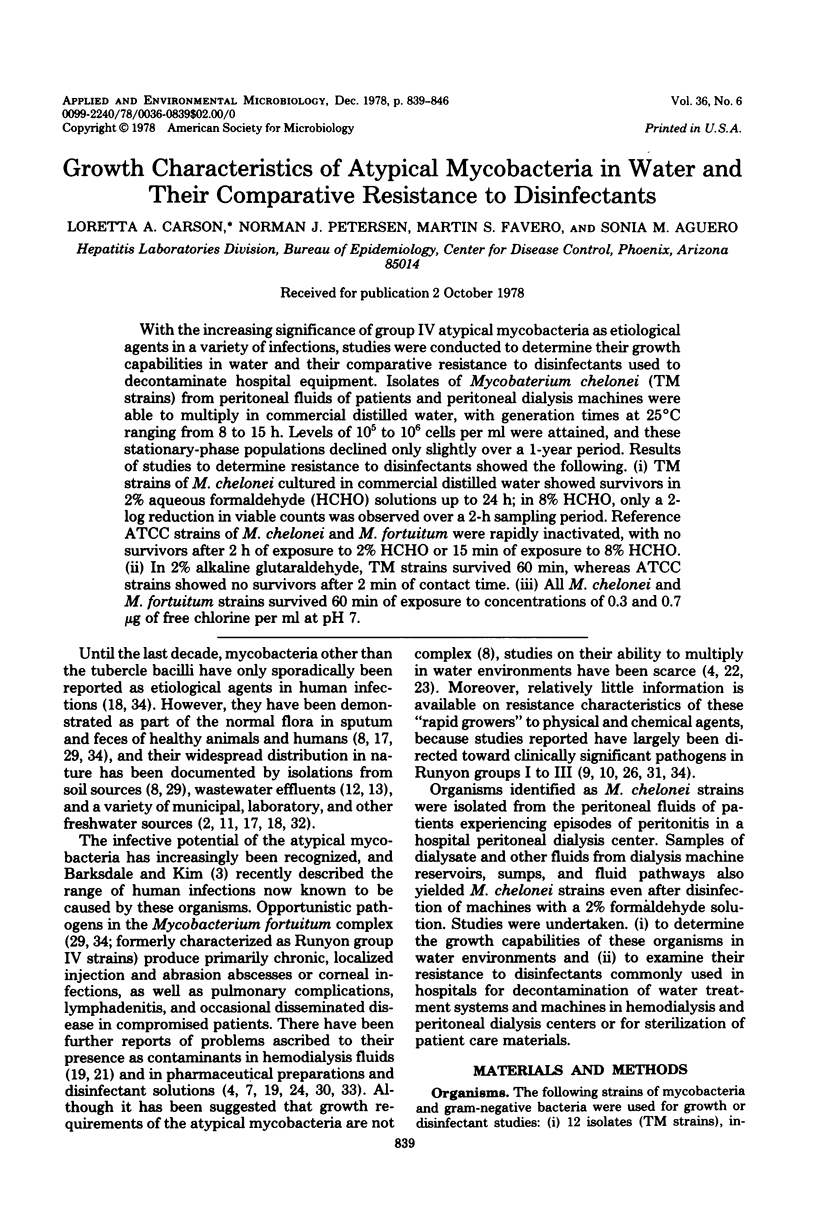

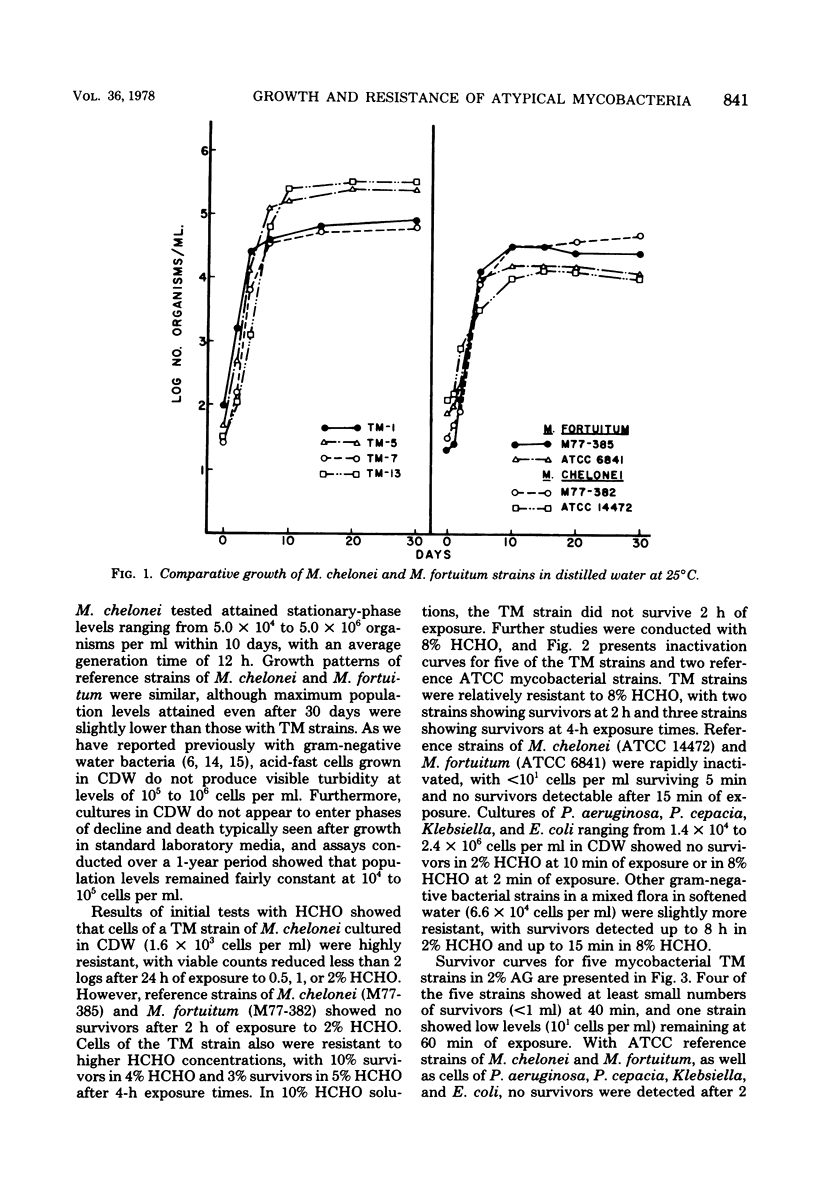
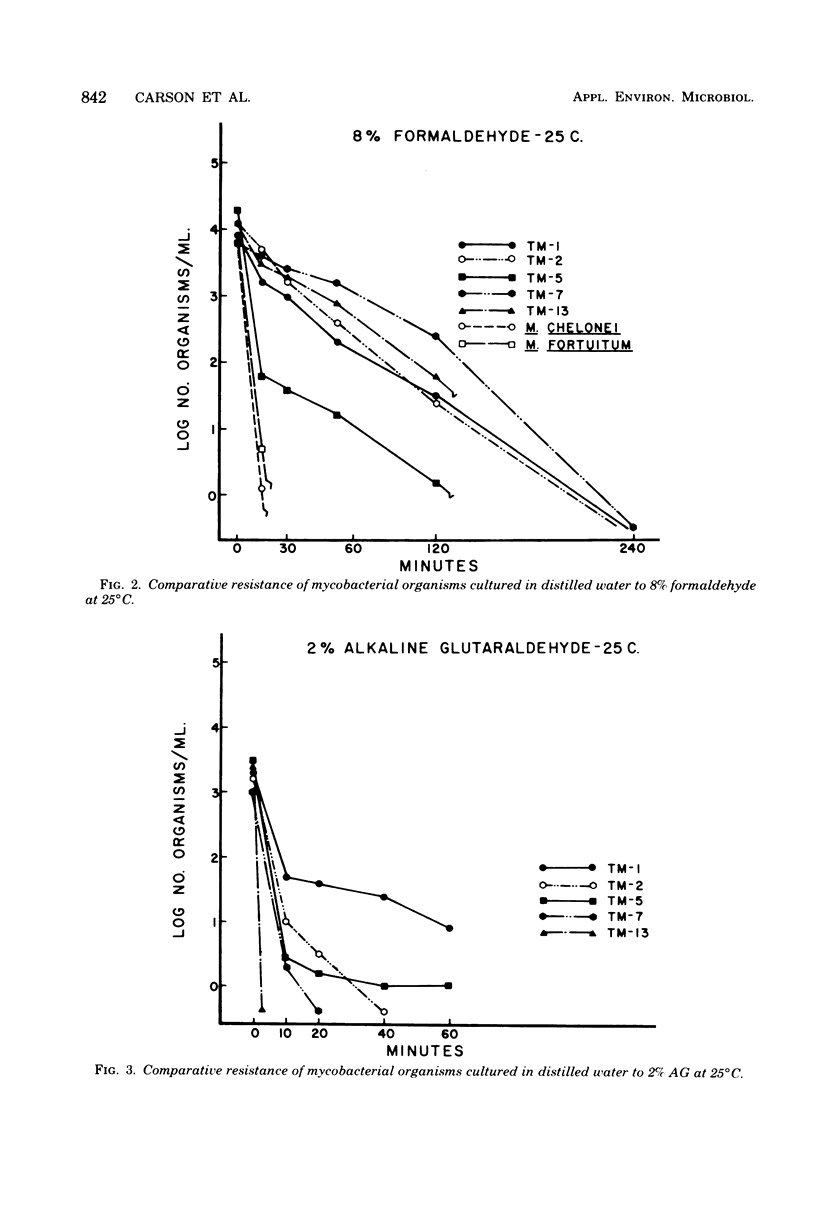


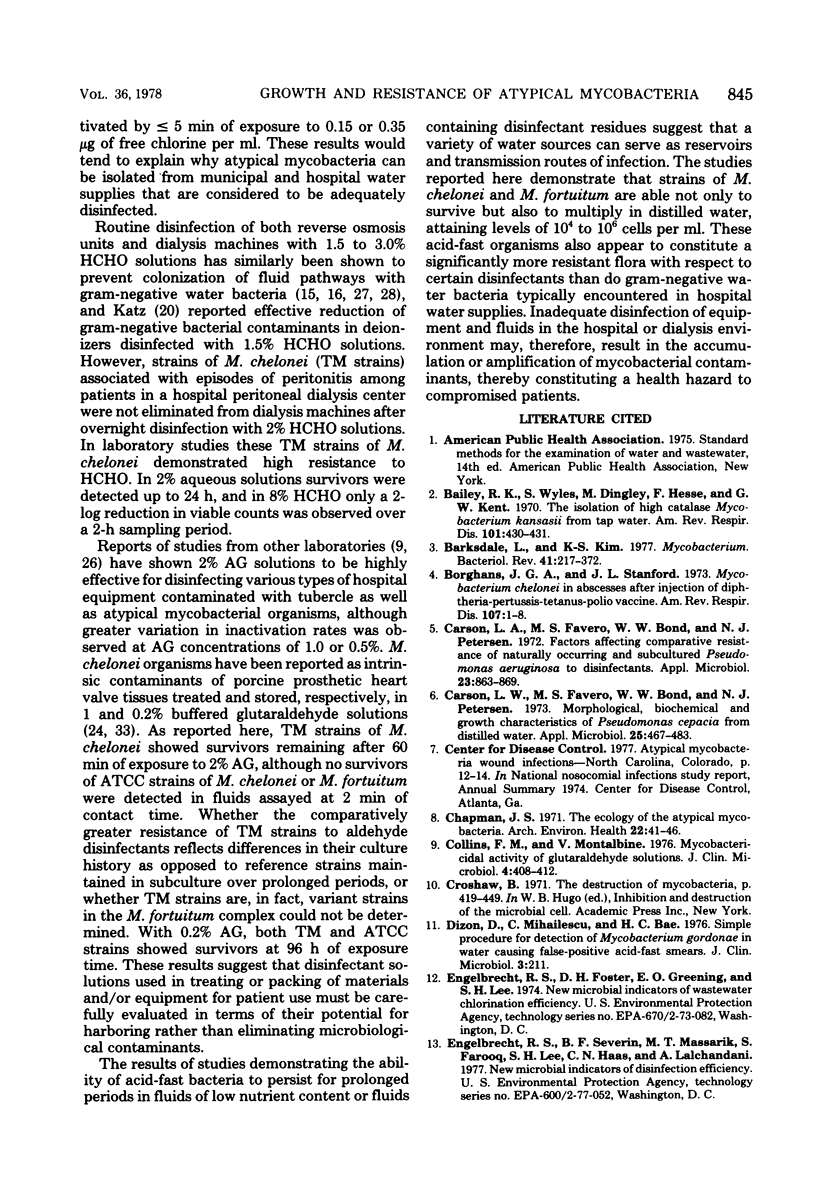
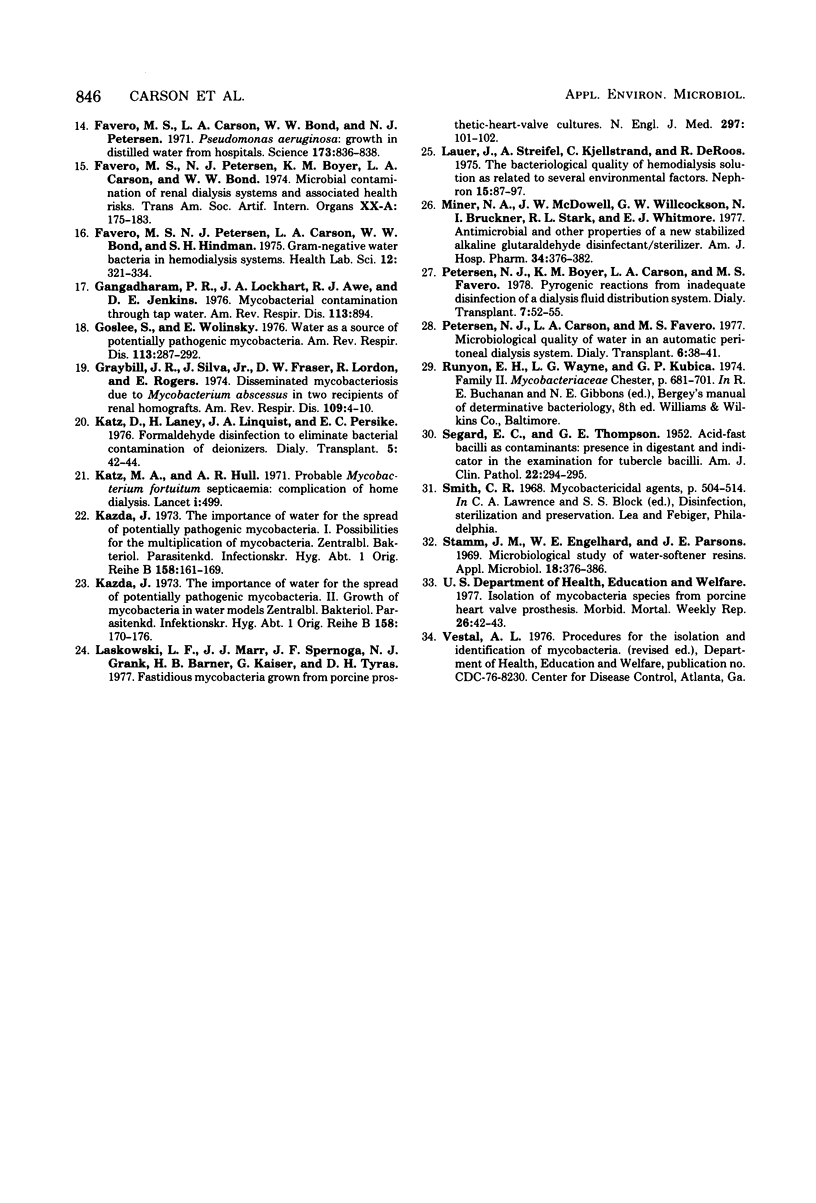
Selected References
These references are in PubMed. This may not be the complete list of references from this article.
- Bailey R. K., Wyles S., Dingley M., Hesse F., Kent G. W. The isolation of high catalase Mycobacterium kansasii from tap water. Am Rev Respir Dis. 1970 Mar;101(3):430–431. doi: 10.1164/arrd.1970.101.3.430. [DOI] [PubMed] [Google Scholar]
- Barksdale L., Kim K. S. Mycobacterium. Bacteriol Rev. 1977 Mar;41(1):217–372. doi: 10.1128/br.41.1.217-372.1977. [DOI] [PMC free article] [PubMed] [Google Scholar]
- Borghans J. G., Stanford J. L. Mycobacterium chelonei in abscesses after injection of diphtheria-pertussis-tetanus-polio vaccine. Am Rev Respir Dis. 1973 Jan;107(1):1–8. doi: 10.1164/arrd.1973.107.1.1. [DOI] [PubMed] [Google Scholar]
- Carson L. A., Favero M. S., Bond W. W., Petersen N. J. Factors affecting comparative resistance of naturally occurring and subcultured Pseudomonas aeruginosa to disinfectants. Appl Microbiol. 1972 May;23(5):863–869. doi: 10.1128/am.23.5.863-869.1972. [DOI] [PMC free article] [PubMed] [Google Scholar]
- Chapman J. S. The ecology of the atypicalmycobacteria. Arch Environ Health. 1971 Jan;22(1):41–46. doi: 10.1080/00039896.1971.10665813. [DOI] [PubMed] [Google Scholar]
- Collins F. M., Montalbine V. Mycobactericidal activity of glutaraldehyde solutions. J Clin Microbiol. 1976 Nov;4(5):408–412. doi: 10.1128/jcm.4.5.408-412.1976. [DOI] [PMC free article] [PubMed] [Google Scholar]
- Dizon D., Mihailescu C., Bae H. C. Simple procedure for detection of Mycobacterium gordonae in water causing false-positive acid-fast smears. J Clin Microbiol. 1976 Feb;3(2):211–211. doi: 10.1128/jcm.3.2.211-211.1976. [DOI] [PMC free article] [PubMed] [Google Scholar]
- Favero M. S., Carson L. A., Bond W. W., Petersen N. J. Pseudomonas aeruginosa: growth in distilled water from hospitals. Science. 1971 Aug 27;173(3999):836–838. doi: 10.1126/science.173.3999.836. [DOI] [PubMed] [Google Scholar]
- Favero M. S., Petersen N. J., Boyer K. M., Carson L. A., Bond W. W. Microbial contamination of renal dialysis systems and associated health risks. Trans Am Soc Artif Intern Organs. 1974;20A:175–183. [PubMed] [Google Scholar]
- Favero M. S., Petersen N. J., Carson L. A., Bond W. W., Hindman S. H. Gram-negative water bacteria in hemodialysis systems. Health Lab Sci. 1975 Oct;12(4):321–334. [PubMed] [Google Scholar]
- Goslee S., Wolinsky E. Water as a source of potentially pathogenic mycobacteria. Am Rev Respir Dis. 1976 Mar;113(3):287–292. doi: 10.1164/arrd.1976.113.3.287. [DOI] [PubMed] [Google Scholar]
- Graybill J. R., Silva J., Jr, Fraser D. W., Lordon R., Rogers E. Disseminated mycobacteriosis due to Mycobacterium abcessus in two recipients of renal homografts. Am Rev Respir Dis. 1974 Jan;109(1):4–10. doi: 10.1164/arrd.1974.109.1.4. [DOI] [PubMed] [Google Scholar]
- Katz M. A., Hull A. R. Probable Mycobacterium fortuitum septicemia: complication of home dialysis. Lancet. 1971 Mar 6;1(7697):499–499. doi: 10.1016/s0140-6736(71)91116-0. [DOI] [PubMed] [Google Scholar]
- Kazda J. Die Bedeutung von Wasser für die Verbreitung von potentiell pathogenen Mykobakterien. I. Möglichkeiten für eine Vermehrung von Mykobakterien. Zentralbl Bakteriol Orig B. 1973 Oct;158(2):161–169. [PubMed] [Google Scholar]
- Kazda J. Die Bedeutung von Wasser für die Verbreitung von potentiell pathogenen Mykobakterien. II. Vermehrung der Mykobakterien in Gewässermodellen. Zentralbl Bakteriol Orig B. 1973 Oct;158(2):170–176. [PubMed] [Google Scholar]
- Laskowski L. F., Marr J. J., Spernoga J. F., Frank N. J., Barner H. B., Kaiser G., Tyras D. H. Fastidious mycobacteria grown from porcine prosthetic-heart-valve cultures. N Engl J Med. 1977 Jul 14;297(2):101–102. doi: 10.1056/NEJM197707142970209. [DOI] [PubMed] [Google Scholar]
- Lauer J., Streifel A., Kjellstrand C., DeRoos R. The bacteriological quality of hemodialysis solution as related to several environmental factors. Nephron. 1975;15(2):87–97. doi: 10.1159/000180500. [DOI] [PubMed] [Google Scholar]
- Miner N. A., McDowell J. W., Willcockson G. W., Bruckner N. I., Stark R. L., Whitmore E. J. Antimicrobial and other properties of a new stabilized alkaline glutaraldehyde disinfectant/sterilizer. Am J Hosp Pharm. 1977 Apr;34(4):376–382. [PubMed] [Google Scholar]
- SEGARD E. C., THOMPSON G. E. Acidfast bacilli as contaminants; presence in digestant and indicator in the examination for tubercle bacilli. Am J Clin Pathol. 1952 Mar;22(3):294–295. doi: 10.1093/ajcp/22.3_ts.294. [DOI] [PubMed] [Google Scholar]
- Stamm J. M., Engelhard W. E., Parsons J. E. Microbiological study of water-softener resins. Appl Microbiol. 1969 Sep;18(3):376–386. doi: 10.1128/am.18.3.376-386.1969. [DOI] [PMC free article] [PubMed] [Google Scholar]


